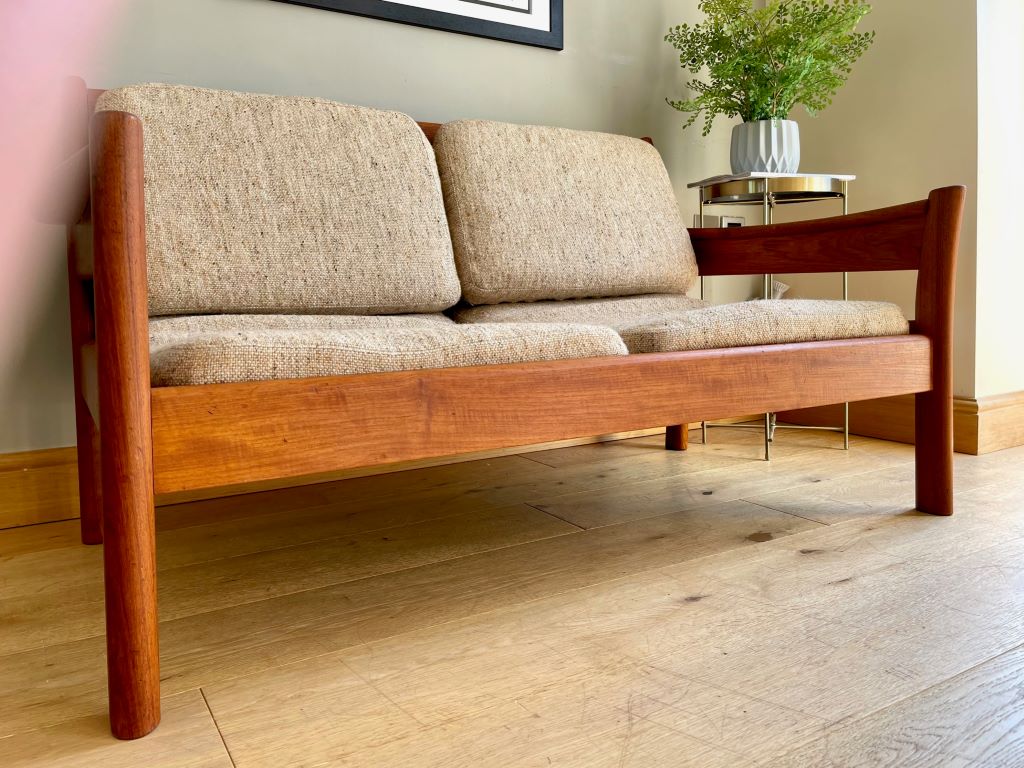This article explores the enduring appeal of danish teak wood, its rich history, iconic designs, and the reasons why it remains a coveted material in furniture making and interior design today.
The Golden Age of Danish Teak Design

The mid-20th century witnessed an explosion of creativity in Danish furniture design, often referred to as the “Golden Age.” Danish teak wood played a central role in this movement, prized for its warmth, durability, and the beautiful grain patterns it offered. Let’s delve into what made this era so special and why teak was the material of choice.
Simplicity and Functionality: The Core Principles
At its heart, Danish design is guided by the principles of simplicity and functionality. It’s about creating beautiful objects that are also practical and enhance daily life. This contrasts sharply with more ornate and elaborate styles that were popular in other parts of the world at the time. Designers sought to create pieces that were visually appealing without being overly decorative. Danish teak wood aligned perfectly with this ethos. Its natural beauty eliminated the need for excessive ornamentation. Instead, the focus was on clean lines, elegant shapes, and the inherent warmth of the wood itself. Think about a classic Danish sideboard – the beauty lies not in intricate carvings but in the seamless flow of the design and the rich, even color of the teak veneer.
Functionality was equally important. Furniture was designed to be comfortable, durable, and adaptable to different spaces. Chairs were ergonomically designed, tables were the right height for working or dining, and storage solutions were cleverly conceived to maximize space. Teak, being a naturally strong and weather-resistant wood, was an ideal choice for creating furniture that could withstand everyday use for generations. The marriage of form and function is really what defines classic Danish design.
This focus on simplicity wasn’t just about aesthetics. It was also a reflection of the post-war social and economic climate. There was a need for affordable, well-designed furniture that could be mass-produced without sacrificing quality. Teak, while not the cheapest option, offered a good balance between cost, durability, and aesthetic appeal.
Key Designers and Their Teak Masterpieces
The Golden Age of Danish design wouldn’t be what it is without the visionary designers who pioneered the movement. Names like Hans Wegner, Arne Jacobsen, Finn Juhl, and Børge Mogensen are synonymous with Danish modernism, and they all utilized Danish teak wood extensively in their creations.
Hans Wegner, often considered the master of the chair, created some of the most iconic teak chairs ever designed. The Wishbone Chair and the Round Chair are prime examples of his ability to blend form and function seamlessly, showcasing the beauty of the wood while providing exceptional comfort and support. Arne Jacobsen, known for his architectural designs, also created stunning teak furniture such as the Series 7 chair, which pushed the boundaries of plywood bending techniques. Finn Juhl, with his more organic and sculptural designs, employed teak to create pieces that resembled works of art as much as they did furniture. Børge Mogensen focused on creating practical and affordable furniture for the average Danish home.
These designers weren’t just creating furniture; they were creating legacies. Their pieces are not just functional objects, they are works of art that reflect a specific time and place. The use of teak was integral to their aesthetic, allowing them to achieve warm, inviting, and durable designs.
The Enduring Appeal of Danish Teak Furniture
Decades after its initial popularity, Danish teak furniture continues to be highly sought after. Its enduring appeal can be attributed to several factors, including its timeless design, exceptional craftsmanship, and the inherent qualities of teak wood itself.
The clean lines and simple forms of Danish design are as relevant today as they were in the mid-20th century. In an era of mass-produced, disposable furniture, the quality and craftsmanship of Danish teak pieces stand out. These pieces were built to last. The beauty of the wood itself is also a major draw. The warm tone and unique grain patterns of Danish teak wood add character and depth to any interior space. Furthermore, there’s a certain nostalgia associated with Danish modern furniture. It evokes a sense of sophistication and elegance that many people find appealing. As environmental awareness grows, buyers are looking for sustainable and durable options. Teak furniture typically has a very long life cycle, making furniture made from Danish teak wood a more eco-conscious choice compared to buying new products.
Identifying Authentic Danish Teak Wood Furniture

Knowing what to look for is crucial when seeking authentic Danish teak furniture. The market is full of reproductions and furniture styled resembling original Danish teak wood pieces. This section will explore the telltale signs of authenticity.
Construction Techniques and Joinery
Original Danish teak furniture are of great quality and uses advanced techniques. The joinery is a major indicator of authenticity and quality. Look for dovetail joints in drawers, mortise and tenon joints in frames, and other evidence of meticulous hand craftsmanship. Mass-produced furniture will often use simpler and less durable joining methods such as screws or staples.
In authentic Danish teak wood furniture, the wood itself is carefully selected and matched to create a seamless appearance. Look for consistent grain patterns and color variations. Details like the way the wood is shaped and finished can also be clues. Original Danish pieces usually went through rigorous sanding and were finished with high-quality oils or lacquers to enhance the beauty of the wood.
Pay attention to the hardware, such as hinges, pulls, and knobs. The quality of the hardware should be consistent with the overall quality of the piece. Original hardware might be made of brass, stainless steel, or even teak wood. A great way to find authentic furniture is to do some research.
Maker’s Marks and Labels
This is one of the easier ways to spot the real deal. Many original pieces were marked with the maker’s mark or label, often found on the underside of the furniture or inside drawers. These marks can provide valuable information about the manufacturer, designer, and the furniture’s origin. Even if you can’t identify the maker immediately, the presence of a mark is a good sign that the piece is likely authentic.
However, it’s worth noting that some manufacturers started to reproduce original marks to increase the value of products. So, use it in combination with another method listed in this article.
The Patina and Character of Age
Authentic Danish teak wood furniture will have a certain patina that comes with age. This patina is a subtle sheen that develops on the surface of the wood over time due to oxidation and wear. It can be hard to replicate artificially, which is why it is a strong indicator of age. It may also be marked by a few scratches or a few stains. These aren’t necessarily bad. They simply indicate that it is an older piece.
It’s important to distinguish between genuine patina and damage, though. A real patina is a smooth, even sheen, while damage will likely have deep scratches or stains. If the piece has been refinished, much of the original patina may be lost, making it more difficult to determine its age.
Caring for Your Danish Teak Investment

Caring for your genuine Danish teak wood furniture is essential to preserving its beauty and value. Regular maintenance will keep your pieces looking great for generations.
Cleaning and Oiling
An essential part of caring for Danish teak wood furniture is regular cleaning. Use a soft, damp cloth to wipe down the furniture’s surfaces regularly. Avoid using harsh chemicals or abrasive cleaners, as these can damage the finish. For more stubborn dirt or stains, use mild soap and water. Be sure to dry the furniture thoroughly after cleaning to prevent water damage.
Teak wood contains natural oils that protect it from moisture and decay. Over time, however, these oils can dry out, causing the wood to become brittle and faded. Oiling your teak furniture helps replenish these essential oils and maintain its natural beauty. Use a high-quality teak oil that is specifically formulated for furniture. Apply the oil with a clean cloth, working it into the wood grain. Allow the oil to soak in for at least 24 hours. Then, wipe off any excess oil with a clean cloth.
How often you need to oil your teak furniture will depend on the climate and the amount of use it gets. In general, it’s a good idea to oil your furniture at least once a year. If you live in a dry climate or your furniture is exposed to direct sunlight, you may need to oil it more frequently.
Avoiding Damage and Repairing Scratches
Teak is a durable wood, but it is still susceptible to damage from scratches, dents, and spills. To protect your furniture, use coasters and placemats when placing drinks and food on the table. Avoid placing hot items directly on the wood surface, as this can cause it to warp or discolor. If you do spill something on your furniture, wipe it up immediately with a clean cloth. It is best to avoid placing teak near direct sunlight as this might lead to the wood fading over time.
If your Danish teak wood furniture does get scratched or dented, it is possible to repair it yourself. For minor scratches, you can use a touch-up pen that matches the color of the wood. For deeper scratches, you may need to sand the area lightly and apply a new coat of finish or oil. For more extensive damage, it’s best to consult with a professional furniture restorer. They can advise you on the best course of action and ensure that the repair is done correctly.
The Sustainable Future of Teak

The current sourcing and production of teak are subject to increased scrutiny. It’s important to understand the challenges and progress being made in ensuring a sustainable future for using Danish teak wood.
Responsible Sourcing and Certification
Responsible sourcing of teak is crucial to protect forests. Due to its high value, illegal logging has been a problem with teak. Look for teak that is certified by organizations like the Forest Stewardship Council (FSC). This certification ensures that the teak comes from sustainably managed forests where trees are harvested responsibly and the environment is protected.
Avoid purchasing teak from companies that cannot provide documentation of their sourcing practices. When shopping for teak outdoor furniture, look for clear indicators of responsible sourcing. Certified Danish teak wood guarantees that the product follows sustainable standards.
The Role of Reclaimed and Recycled Teak
Recycled teak is a good alternative to freshly harvested wood. Reclaimed teak comes from old buildings, boats, and furniture. It has the benefits of being already seasoned and full of character. Reclaimed teak is a sustainable choice because it reduces the demand for new teak and helps to reduce waste. It also helps to reduce your environmental footprint.
This article has mentioned the importance of the history of the material and the way it has been used over the generations. Using reclaimed teak continues to add to the overall history of the Danish teak wood story.
Innovations in Teak Alternatives
Due to the concerns surrounding teak sourcing, there has been an increased interest in alternative wood species that mimic the properties of teak. Some of these alternatives include Iroko, Accoya, and thermally modified wood. Iroko, which is sometimes known as African teak, is durable but lacks teak’s golden color and might require more maintenance. Aacoya is radiata pine that modified through acetylation, making it resistant to rot and insects.
Other sustainable options, such as bamboo or recycled plastic lumber, offer durability and resistance to water damage, making them suitable for outdoor furniture. Each material possesses unique characteristics and impacts on the environment. The exploration of sustainable alternatives is essential for the future of woodworking.
FAQs About Danish Teak Wood
Here are some frequently asked questions about danish teak wood:
What makes Danish teak wood so special?
Danish teak wood is prized for its warm color, beautiful grain patterns, durability, and resistance to moisture and decay. It was widely used in mid-century modern furniture design.
How can I tell if a piece of furniture is made of genuine Danish teak wood?
Look for hallmarks such as quality construction techniques, maker’s marks, original hardware, and the presence of patina. Be aware of furniture marketed to look like Danish teak wood that will not wear as well.
How do I care of Danish teak wood furniture?
Clean it regularly with a soft, damp cloth and oil it annually (or more frequently) with high end teak oil to replenish its natural oils. Avoid harsh chemicals and protect the surface from heat and spills by the use of coasters and placemats.
Is buying Danish teak sustainable?
Ensure that the teak is responsibly sourced and from an organization like the Forest Stewardship Council (FSC). Choosing reclaimed teak is an even more sustainable option.
Where can I buy authentic Danish teak furniture?
You can find authentic Danish teak furniture at antique stores, vintage furniture dealers, online marketplaces, and auction houses. Be sure to do your research and purchase from reputable sources.
Video
Video source from Youtube
Conclusion
Danish teak wood furniture represents a confluence of design, craftsmanship, and material excellence. Its enduring popularity is a testament to the timelessness of Danish modern design and the inherent beauty of teak wood. By understanding its history, identifying authentic pieces, and properly caring for your investment, you can enjoy the elegance and legacy of Danish teak for generations.
Read also : How Do You Use Teak Oil on Wood? – Reviving and Protecting Your Wood’s Beauty
